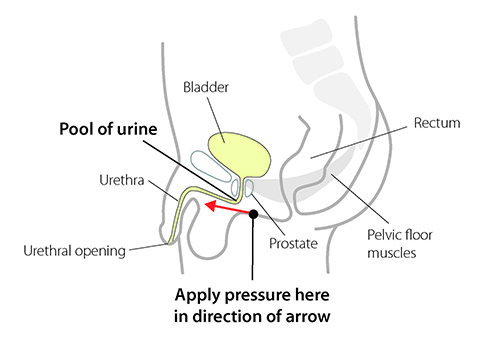You may have heard the saying “no matter how hard you shake it the last drop always goes down your leg”. This is the condition called post-micturition dribbling (PMD), common amongst men “of a certain age” that probably does not get the attention it deserves. It can cause considerable distress and even result in the need to change wet underwear - or even conceal wet outer-wear.
For men, gravity and muscle weakness are responsible for urinary dribble. The male urethra does not run in a straight downhill line. It has a little dip in the middle of it, creating a pool where urine can collect. Normally, a muscle called the bulbocavernosus that fits around the urethra will automatically squeeze to force the urine out, but this muscle can lose its tone, especially in men older than 50 years.
Sometimes movement and gravity will cause the last few drops of urine that pool up in the dip of the urethra to involuntarily spill out of the body at an unpredictable time, leading to those embarrassing wet spots.
The statistics vary on how common this condition is, with some studies suggesting it may be over 50% in older men. It certainly increases with advancing years. In an ageing population it is growing in prevalence and is often associated with other lower urinary tract symptoms (LUTS) and sometimes with erectile dysfunction (ED).
The amount of urine lost is variable. One study shows that in those experiencing ED the leakage was approximately 2.1 mls, compared with 1.2 mls for those not having ED.
PMD can occur in women but less commonly.. A good and recent review article of many studies on this topic can be found in the Journal: Investigative and Clinical Urology 2019 May; 60(3): 142-147 titled, A current perspective on post-micturition dribble in males.
The abstract of this paper states:
“Post-micturition dribble (PMD) is the involuntary loss of urine immediately after urination. It is classified as a post-micturition symptom and is more common in males. Traditionally, PMD has been considered part of the aging process, to have a low prevalence, and to be less bothersome than other lower urinary tract symptoms (LUTS).
“However, recent evidence suggests that PMD is not less common and does not elicit less discomfort compared with other LUTS in males. Also, PMD seems to commonly overlap with other LUTS and to be associated with erectile dysfunction. Although the etiology of PMD is not fully understood, a weakness or failure of the pelvic floor muscles is considered the most important factor. Although bulbar urethral massage and pelvic floor exercises are known to be effective in treating PMD, pharmacologic treatment has not yet been introduced. Recently, the possibility of treating PMD with phosphodiesterase-5 inhibitor has been suggested.”
When it comes to GP management an appropriate medical history and examination is the first step. Depending on the findings a referral to a Urologist may be indicated.
”Bulbar urethral massage is usually of some benefit…”
In regard to treatment there are few options and the benefits of pharmaceutical intervention is still not conclusive. However, there is one simple self-help procedure that can be taught to patients - bulbar urethral massage. It is usually of some benefit and can complement the encouragement of pelvic floor exercises.
The technique for this Bulbar urethral massage instructions for patients is as follows (see accompanying diagram):
- Pass urine in the usual way then wait a few seconds to allow your bladder to empty
- Place the fingertips of your hand about 3 finger widths behind your scrotum and press gently
- Still applying pressure, bring your fingers towards the base of your penis
- This pushes the urine forward from the bulbar urethra into the penile urethra where it can be emptied by shaking or squeezing in the usual way.
- Repeat this process twice to ensure that the urethra is completely empty
- Practise this technique at home
- When in a public toilet it may be advisable to use a cubicle for more privacy. (see diagram).
Note: this procedure can be done through clothing which may be more acceptable for men standing at a urinal.
In conclusion, PMD is often ignored as just being on the list of inevitable problems as one grows older. It probably deserves more attention and research to find improved treatments. Maybe there will be medications that help in the future, but meantime this simple self-help management of bulbar urethral massage along with pelvic floor exercises has a vital role to play.
















